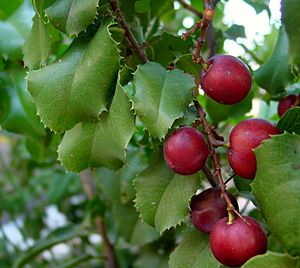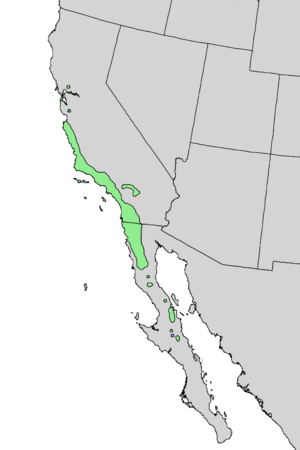Hollyleaf cherry facts for kids
Quick facts for kids Hollyleaf cherry |
|
|---|---|
 |
|
| Conservation status | |
| Scientific classification | |
 |
|
| Natural range of Prunus ilicifolia (var. ilicifolia green; var. occidentalis blue) | |
| Synonyms | |
|
The hollyleaf cherry (scientific name: Prunus ilicifolia) is a cool plant that grows in California and Baja California. People also call it the evergreen cherry or islay. Even though it's called a cherry, it's not exactly like the cherries you might eat from a grocery store. It's more like a distant cousin!
This plant is special because it stays green all year round. It can be a small bush or grow into a tree as tall as 30 feet (9 meters). Its leaves look a lot like holly leaves, which is how it got its name. The word "ilicifolia" means "holly-leaved" in Latin.
Contents
Meet the Hollyleaf Cherry!
The hollyleaf cherry is an evergreen shrub or a small tree. It can grow up to 50 feet (15 meters) tall. Its leaves are thick and tough, about 0.6 to 4.8 inches (1.6–12 cm) long. They have spiny edges, just like a holly plant. When the leaves are fully grown, they are dark green and shiny. If you crush them, they might smell a bit like almonds, but don't eat them, as they are poisonous!
In spring, usually from March to May, the plant grows small white flowers. These flowers are tiny, only about 0.04 to 0.2 inches (1–5 mm) big. They grow in clusters, similar to other plants in the rose family.
After the flowers, the plant produces fruit. These fruits are like small cherries, about 0.5 to 1 inch (12–25 mm) wide. They can be purple or black and taste sweet. Inside, there's a very thin layer of fruit around a large seed. This type of fruit with a single large seed is called a drupe.
Different Kinds of Hollyleaf Cherry
There are two main types, or subspecies, of the hollyleaf cherry:
- P. ilicifolia subsp. ilicifolia: This type grows on the mainland of California and Baja California. Its fruit is red and about 0.5 to 0.7 inches (12–18 mm) wide.
- P. ilicifolia subsp. lyonii: This one is called the Catalina cherry. It's found on the Channel Islands off the coast of California. Its fruit is blue-black and a bit bigger, about 0.6 to 1 inch (15–25 mm) wide.
Where Does It Grow?
The hollyleaf cherry naturally grows in the chaparral and foothill woodland areas of California. You can find it along the Coast Ranges, from northern Baja California all the way up the California coast. It also grows in the desert chaparral parts of the Mojave desert.
In chaparral areas, it often grows on slopes that face north or in places that are cooler and have more moisture. It's a tough plant that grows slowly but lives for a long time. It can outlast or outgrow other plants around it. Over time, it can even form large groups with scrub oak.
How New Plants Grow
When there's a fire, the hollyleaf cherry can grow back from its stump. However, its seeds are not like those of many other chaparral plants that need fire to sprout. Instead, its seeds need sunlight to grow. They rely on other plants dying naturally over a long time without fires to create space for new hollyleaf cherry seedlings to sprout.
Home for Butterflies
Many butterfly caterpillars love to munch on the leaves of the hollyleaf cherry! It's a food source for the pale swallowtail butterfly. It's also a host plant for the California hairstreak, Lorquin's admiral, Nevada buckmoth, and the tiger swallowtail.
Growing Hollyleaf Cherry
People love to plant hollyleaf cherries in their gardens, especially in California. It's a great choice for native plant gardens and wildlife gardens because it doesn't need much water once it's grown. It's also used in drought-tolerant sustainable landscaping.
This plant is easy to grow from seeds. It likes lots of sun and soil that drains well. While it can handle dry conditions, it needs regular watering when it's young. Bees are also very attracted to its flowers!
Uses of the Hollyleaf Cherry
Long ago, Native Americans used the fruit of the hollyleaf cherry in interesting ways. They would ferment the fruit to make a drink. Some also cracked open the dried cherries and ground the seeds into a meal after treating them. Today, people sometimes make jam from the fruit.
Images for kids




